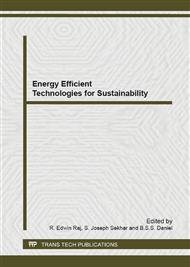[1]
Brito M.A. G, Junior L. G, Sampaio L.P., Canesin C. A, Evaluation of MPPT techniques for photovoltaic applications, IEEE international symposium on Industrial Electronics –ISIE , 21, pp.1039-1044, (2011).
DOI: 10.1109/isie.2011.5984303
Google Scholar
[2]
G. Walker, Evaluating MPPT converter topologies using a matlab PV model, J. Elect. Electron. Eng., Australia, vol. 21, no. 1, p.45–55, (2001).
Google Scholar
[3]
Marcelo Gradella Villalva, Jonas Rafael Gazoli, and Ernesto Ruppert Filho, Comprehensive Approach to Modeling and Simulation of Photovoltaic Arrays, IEEE Transactions on Power Electronics, vol. 24, no. 5, pp.1198-1208, , (2009).
DOI: 10.1109/tpel.2009.2013862
Google Scholar
[4]
Altas I.H. and Sharaf.A. M, A photovoltaic array simulation model for matlab–simulink GUI environment, in Proc. Int. Conf. Clean Elect. Power (ICCEP), p.341–345, (2007).
DOI: 10.1109/iccep.2007.384234
Google Scholar
[5]
R. Ramaprabha and B.L. Mathur, Comparative Study of Series and Parallel configurations of Solar PV Array under Partial Shaded Conditions, International Review on Modeling and Simulation, vol. 3. no. 6, pp.1363-1371, (2010).
DOI: 10.1109/icset.2008.4746963
Google Scholar
[6]
J.A. Gow and C.D. Manning, Development of a Model for Photovoltaic Arrays Suitable for use in Simulation Studies of Solar Energy Conversion systems, Power Electronics and Variable Speed Drives, Conference Publication No. 429, 1996, pp.69-74.
DOI: 10.1049/cp:19960890
Google Scholar
[7]
J.A. Duffie and W.A. Beckman, Solar Engineering of Thermal Processes (John Wiley Sons, 3rd edition, 2006).
Google Scholar
[8]
Celik A.N. and Acikgoz.N. (2007), Modelling and experimental verification of the operating current of mono-crystalline photovoltaic modules using four- and five-parameter models, Applied Energy, Vol. 84, no. 1, p.1–15.
DOI: 10.1016/j.apenergy.2006.04.007
Google Scholar
[9]
T. Esram and P. L. Chapman, Comparison of photovoltaic array maximum power point tracking techniques, IEEE Trans. Energy Convers, vol. 22, no. 2, p.439–449, Jun. (2007).
DOI: 10.1109/tec.2006.874230
Google Scholar
[10]
Joe-Air Jiang, Tsong-Liang Huang, Ying-Tung Hsiao, Chia- Hong Chen, Maximum Power Tracking for Photovoltaic Power Systems, Tamkang Journal of Science and Engineering, 2005, Vol. 8, No. 2, pp.147-153.
Google Scholar
[11]
N. Femia, D. Granozio, G. Petrone, and M. Vitelli, Predictive & adaptive MPPT perturb and observe method, IEEE Trans. Aerosp. Electron. Syst., vol. 43, no. 3, p.934–950, Jul. (2007).
DOI: 10.1109/taes.2007.4383584
Google Scholar
[12]
N. Femia, G. Petrone, and M. Vitelli, Optimization of perturb and observe maximum power point tracking method, IEEE Trans. Power Electron., vol. 20, no. 4, p.963–973, Jul. (2005).
DOI: 10.1109/tpel.2005.850975
Google Scholar
[13]
Y.C. Kuo, T-J Liang and J.F. Chen, Novel maximum power point tracking controller for photovoltaic energy conversion systems, IEEE Transactions on Industrial Electronics, Vol. 48, No. 3, June 2001, pp.594-601.
DOI: 10.1109/41.925586
Google Scholar
[14]
K. H. Hussein, I. Muta, T. Hoshino, and M. Osakada, Maximum photovoltaic power tracking: An algorithm for rapidly changing atmospheric conditions, IEE Proc. —Gener., Transm. Distrib., vol. 142, no. 1, pp.59-64, (1995).
DOI: 10.1049/ip-gtd:19951577
Google Scholar
[15]
T. L. Kottas, Y. S. Boutalis, and A. D. Karlis, New maximum power point tracker for PV arrays using fuzzy controller in close cooperation with fuzzy cognitive networks, IEEE Trans. Energy Convers., vol. 21 no. 3, p.793–803, Sep. (2006).
DOI: 10.1109/tec.2006.875430
Google Scholar
[16]
C. -S. Chiu, T-S fuzzy maximum power point tracking control of solar power generation systems, IEEE Trans. Energy Convers., vol. 25, no. 4 p.1123–1132, Dec. (2010).
DOI: 10.1109/tec.2010.2041551
Google Scholar
[17]
www. mathworks. com.
Google Scholar


